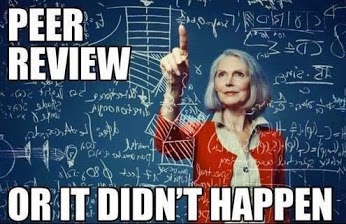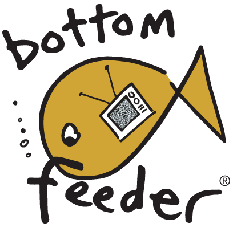
Is peer-review really a “gold standard?” Credit: Peer review, or it didn’t happen
Occasionally groups with an anti-science message will get hold of a ‘peer reviewed’ paper in a scientific journal which fits their message completely. They will promote it heavily as scientific ‘proof” for their message. This is currently happening with a paper published in the Scientific World Journal. Its content (sometimes its full text) is being repeated in multiple newspapers and on-line sites (such as 18 Scientifically Validated Reasons to End Public Water Fluoridation – Waking Times). And it has become the latest hot link shared by drive-by trolls on blogs sites, Facebook and Twitter. The paper is Peckham & Awofeso (2014), Water Fluoridation: A Critical Review of the Physiological Effects of Ingested Fluoride as a Public Health Intervention, The Scientific World Journal Volume 2014 (2014).
Have a read if you have not already seen it. There is nothing new or challenging in it. If you can read anti-fluoridation articles by Paul Connett or Declan Waugh you can read this. It may just as well have been copypasta from Connett’s book or one of Waugh’s reports.
Peer-review a “gold standard?”
This paper illustrates a concern I have that many people see publication in a peer-reviewed scientific journal as some sort of “proof” of truth. Interestingly though, this is not the attitude of active researchers. Sure, that is where they look for previous credible findings and possible methodologies but, after all, scientists are in the job of at least improving on existing knowledge, if not outright changing it. They do not accept published findings or opinions published in peer-reviewed journals as infallible. I can understand why intelligent people in social debates will treat peer-reviewed scientific papers as some sort of “gold standard.” After all, the usual alternatives they are bombarded with are misinformed and distorted populist articles in ideologically motivated “natural” health magazines and on similar web sites.
But peer review is hardly fool-proof, authors of scientific papers hardly always objective themselves and some scientific journals hardly efficient or necessarily ethical in their peer-review processes. I think everyone who uses citations like these in their debates should be aware of this and approach their use of scientific literature critically and intelligently. They should evaluate authors, the quality of their papers and the reliability of journals’ publishing processes.
Ideologically motivated authors
Of course ideological motivation should not, by itself, mean that arguments used in a paper are invalid. Not at all. But it does require that papers are carefully peer-reviewed. Even an honest author attempting to be fair finds it difficult toa void their bias. An intelligent reader should be aware of an author’s possible motivations and the extent of peer review normally offered by the author’s institution and the journal.
These days it is common for authors to declare any interest – as they did in this statement of conflicts of interest of this paper: – “The authors declare that there is no conflict of interests regarding the publication of this paper.”
Frankly I do not think this is good enough. In this case Stephen Peckman (the senior author) is a former chairperson of the activist group Hampshire Against Fluoridation. He is an active political campaigner on the issue of fluoridation – see, for example, this TV debate on the BBC a few years ago. Perhaps this should have been declared in the “Conflicts of interest” section? At least awareness of this activism is a warning to the intelligent reader to be vigilant in their reading of the paper.
“Bottom-feeding” journals
The intelligent reader should also be conscious of the journal used for publication. Some journals really should ring alarm bells. Not just journals like Fluoride which have a clear political position on fluoride and fluoridation. But journals who have a poor reputation for their peer review and other publishing processes. For example, some journals which charge authors for publication may be financially motivated to publish any old rubbish. Willing to use poor peer reviewers, etc. They may also allow authors to use unethical citation procedures for promotion of themselves or their groups – or raising the journal impact factor.
In general researchers get to know the names of these poor quality journals and avoid them for their own reputations sake. However, such journals (which one commenter has described as “bottom feeders” – see Science Denialists Make Fake Journal, Get Shut Down) do provide a publication avenue for the less scrupulous author who finds difficulty publishing elsewhere. The Scientific World Journal, where Peckham chose to publish this paper, is one of these.
Here are some on-line comments about The Scientific World Journal.
Jeffrey Beall in his article Predatory Publishing:
“One result is that the open-access movement is producing an almost boomtown-like increase in the number of scholarly open-access publishers, fostered by a very low barrier to entrance into the learned publishing industry. To become a scholarly publisher, all you need now is a computer, a website, and the ability to create unique journal titles.
Bolstering this trend is the so-called “gold open-access” model, in which publishing is supported not by subscription fees but by author fees. An example of a gold open-access journal is The Scientific World Journal, currently published by Cairo-based Hindawi Publishing Corporation. This megajournal covers virtually all scientific fields and imposes an article processing charge of $1,000 for each accepted article. “
This “gold open-access” model provides an easy way for unscrupulous authors to buy space for their articles.
Nature reported that The Science World Journal was banned from lists of impact ratings because it allowed the unethical practice of self-citation (see Record number of journals banned for boosting impact factor with self-citations):
“Every year, Thomson Reuters, the firm that publishes the impact-factor rankings, takes action against the most extreme offenders by banning them from the latest lists. It lets them in again, suitably chastened, a couple of years later.
Almost all of those banned [in 2011] are excluded because of excessive self-citation, although three journals — Cell Transplantation, Medical Science Monitor and The Scientific World Journal — apparently worked together to cite each other and thus raise impact factors. That “cartel” was originally reported by Phil Davis on The Scholarly Kitchen, and he has today posted a follow-up article on that ban. “
David Rothschild at Plagiarism Blog also reported that The Scientific World Journal had taken the “unprecedented action” of retracting some of its own papers because of self-citations (see
“In 2011, The Scientific World Journal was excluded from the annual Thomson Reuters Journal Citation Reports for being an accomplice in a ‘citation cartel.’ Phil Davis over at the Scholarly Kitchen first uncovered evidence against the Scientific World Journal for excessive self-citation practices along with two other journals that shared common board members: Cell Transplantation and Medical Science Monitor. This past occurrence has more recently lead to The Scientific World Journaltaking unprecedented action by retracting two of their own papers after finding a number of self-citations in them with the clear goal of improving impact factor rankings. “
Readers can probably relate similar stories of ideologically motivated authors using “bottom feeder” journals to get their material published in an apparent peer-reviewed journal. It has happened a bit in the climate change field. And their are several other examples of the technique being used in the anti-fluoridation movement.
In my article When politicians and bureaucrats decide the science I gave an example of such a paper which the Hamilton City Council had been misinformed by. This is the paper Kauffman, J. M. (2005). Water Fluoridation : a Review of Recent Research and Actions. Journal of American Physicians and Surgeons, 10(2), 38–44.
Quackwatch lists the Journal of American Physicians and Surgeons as an untrustworthy, non-recommended periodical. Investigative journalist Brian Deer described the journal as the:
“house magazine of a right-wing American fringe group, the Arizona-based Association of American Physicians and Surgeons, which campaigns against US vaccination policies. The association is also vocal in opposing moves to combat fraud by private doctors, and medical professional efforts to reduce deaths from domestic firearms. In 2005, Time Magazine reported that the association had only 4,000 members. Although cited by Private Eye in stories attacking MMR, the association’s journal – recently renamed from the Medical Sentinel, presumably for the purpose of attempting to give its ideologically slanted material the aura of science – is barely credible as an independent forum for such material. No objective medical scientist with important information of any standard would submit it to such a publication, unless they couldn’t get it published anywhere else.”
This is the thing about these “bottom-feeding” journals. No reputable researcher uses them for fear of losing their reputation. But they do provide an avenue for papers that couldn’t get published in a reputable journal for reasons of poor quality or because they amount to propaganda for political activists.
Don’t be fooled by such tactics. Always approach articles, even those in “peer-reviewed” journals, critically and intelligently.
And don’t accept at face value the claims by activist propagandists that the material they promote has a scientific stamp of approval.











Good appraisal.
Peer review is a measure of the acceptability of a manuscript to a particular journal, not necessarily validity of the work. Validity can best be judged through critical appraisal, and ultimately through systematic reviews (but even then, the systematic reviews have to be peer reviewed).
The decision on publication really rest with the editor. As well as asking “is the manuscript good enough”, s/he also needs to ask “is the peer review good enough”? I’ve seen manuscripts peer-reviewed by as many as six reviewers when some don’t give sensible or comprehensive reviews. In such cases, the editor can go to additional reviewers to assist with the decision.
When it comes to the final decision, some journal editors set the bar higher, others lower. If an article gets rejected by one journal, unfortunately (or fortunately, depending on your point of view) there are plenty more journals out there and sometimes authors might just go for a bottom-feeding journal. That’s why shonky journals are shonky.
LikeLike
Does anyone know what the internal mechanism is for a journal to be included in PubMed??
LikeLike
Pingback: The irony of some peer-review and citation complaints | Open Parachute